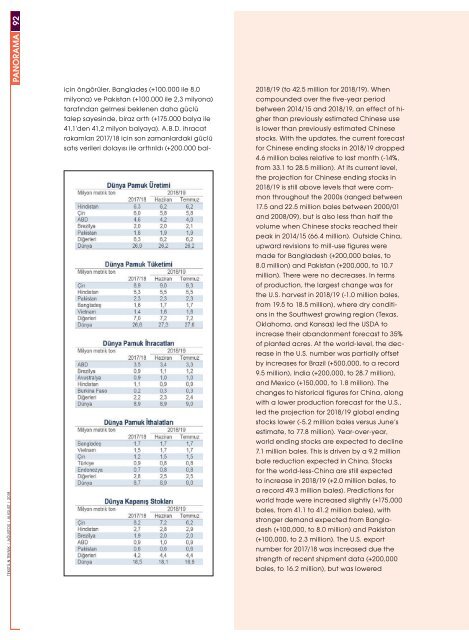You also want an ePaper? Increase the reach of your titles
YUMPU automatically turns print PDFs into web optimized ePapers that Google loves.
PANORAMA<br />
TEKSTİL & TEKNİK | AĞUSTOS | AUGUST | <strong>2018</strong><br />
92<br />
için öngörüler, Bangladeş (+100.000 ile 8,0<br />
milyona) ve Pakistan (+100.000 ile 2,3 milyona)<br />
tarafından gelmesi beklenen daha güçlü<br />
talep sayesinde, biraz arttı (+175.000 balya ile<br />
41,1’den 41,2 milyon balyaya). A.B.D. ihracat<br />
rakamları 2017/18 için son zamanlardaki güçlü<br />
satış verileri dolayısı ile arttırıldı (+200.000 bal-<br />
<strong>2018</strong>/19 (to 42.5 million for <strong>2018</strong>/19). When<br />
compounded over the five-year period<br />
between 2014/15 and <strong>2018</strong>/19, an effect of higher<br />
than previously estimated Chinese use<br />
is lower than previously estimated Chinese<br />
stocks. With the updates, the current forecast<br />
for Chinese ending stocks in <strong>2018</strong>/19 dropped<br />
4.6 million bales relative to last month (-14%,<br />
from 33.1 to 28.5 million). At its current level,<br />
the projection for Chinese ending stocks in<br />
<strong>2018</strong>/19 is still above levels that were common<br />
throughout the 2000s (ranged between<br />
17.5 and 22.5 million bales between 2000/01<br />
and 2008/09), but is also less than half the<br />
volume when Chinese stocks reached their<br />
peak in 2014/15 (66.4 million). Outside China,<br />
upward revisions to mill-use figures were<br />
made for Bangladesh (+200,000 bales, to<br />
8.0 million) and Pakistan (+200,000, to 10.7<br />
million). There were no decreases. In terms<br />
of production, the largest change was for<br />
the U.S. harvest in <strong>2018</strong>/19 (-1.0 million bales,<br />
from 19.5 to 18.5 million), where dry conditions<br />
in the Southwest growing region (Texas,<br />
Oklahoma, and Kansas) led the USDA to<br />
increase their abandonment forecast to 35%<br />
of planted acres. At the world-level, the decrease<br />
in the U.S. number was partially offset<br />
by increases for Brazil (+500,000, to a record<br />
9.5 million), India (+200,000, to 28.7 million),<br />
and Mexico (+150,000, to 1.8 million). The<br />
changes to historical figures for China, along<br />
with a lower production forecast for the U.S.,<br />
led the projection for <strong>2018</strong>/19 global ending<br />
stocks lower (-5.2 million bales versus June’s<br />
estimate, to 77.8 million). Year-over-year,<br />
world ending stocks are expected to decline<br />
7.1 million bales. This is driven by a 9.2 million<br />
bale reduction expected in China. Stocks<br />
for the world-less-China are still expected<br />
to increase in <strong>2018</strong>/19 (+2.0 million bales, to<br />
a record 49.3 million bales). Predictions for<br />
world trade were increased slightly (+175,000<br />
bales, from 41.1 to 41.2 million bales), with<br />
stronger demand expected from Bangladesh<br />
(+100,000, to 8.0 million) and Pakistan<br />
(+100,000, to 2.3 million). The U.S. export<br />
number for 2017/18 was increased due the<br />
strength of recent shipment data (+200,000<br />
bales, to 16.2 million), but was lowered

















